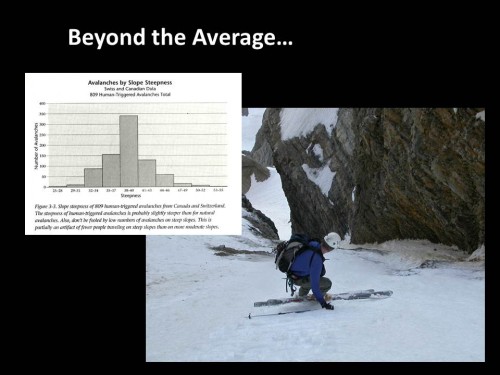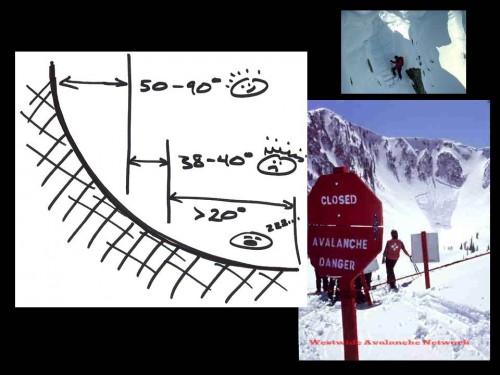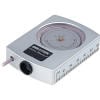1 – Above Average Skiing
Part 1 in a 10 part series on some of my personal avalanche avoidance theories. These are not meant to replace avalanche classes and mostly fall under the “Human Factors” category.
Human triggered avalanches are far more likely to occur on a 38-40 degree slope than any other. The numbers drop off rapidly on both sides of this average, and at the ends of the spectrum, statistics show that a 50+ degree* slope has roughly the same odds of having a human triggered avalanche as as a 30 degree slope. For every 340 human triggered avalanches on 38-40 degree slopes, there are about 10 on slopes steeper than 50 degrees or less than 28. From a steep skier’s perspective, this seems too good to be true: just stick to the steeps and you’ll be fine.
But of course, there is a catch.
Unless you are skiing in an area like Baffin Island where 50 degree slopes come straight out of the flat frozen ocean, there will most likely be a 38-40 degree transition zone, however small, between a 50 degree splitter couloir and the plinky-dink 20 degree aprons below. Not only is this a likely triggering zone, but after the focus and challenge of skiing a steep line, it is easy to let your guard down and think you’ve got it made once the angle mellows out. Unwittingly, the risk of falling while skiing a steep line is instantly replaced with increased avalanche risk.
Wolverine Cirque in the Wasatch Mountains is a perfect illustration of this and a place where I was involved in an avalanche fatality in 1995. Most of the lines start as steep, narrow chutes, then pass through 38 degrees right at the top of the apron, which also gets double loading from the steep slopes above sluffing off. After that, it bellies out onto the flats.
To complicate things, the snowpack and stability in a tight, steep, narrow couloir is probably much different from the apron hundreds or thousands of feet below. After dropping a cornice and doing a roped ski cut, you might find 3” of stable fluff on a solid bed surface in the upper chute, but the 38 degree apron below has a 24” soft slab on top of pooled graupel. The true hazard of this situation is that it can go from low to high danger within the space of a single turn, and this occurs right when the apparent danger of steep skiing is over.
* The lower odds of triggering an avalanche on a 50+ degree slope is due in part to snow sluffing off and/or natural avalanches, but also because less people are skiing them. Chart credit in upper photo: Bruce Tremper – Staying Alive in Avalanche Terrain.
________________________________
Help support StraightChuter.com and take the guesswork out of angles with a Brunton Clinomaster from Backcountry.com. Click on the photo below…
Category: 07 Avalanche Avoidance












Andrew,
Thank you for this. Really looking forward to reading the rest of the series…
Not to dirty my nose but its stuff like this that keeps me checking out your site. That part about easing up after skiing something steeper was a great reinforcement/reminder. Thanks and keep it up Andrew.
Yep, right on!
It’s a pet peeve of mine. There’s safer terrain on BOTH sides of 38 degrees. There’s a graph on the Swiss website as a primer for the general public that shows slope steepness on the vertical axis and the avalanche danger rating on the horizontal axis. The trouble is that it’s just not true. First, it’s not a linear relationship, and second, you can find safer terrain on steeper slopes as well as gentler slopes.
But for most mere mortals, seeking safer terrain usually involves gentler slopes instead of steeper ones. So that’s why you often hear the advice stated that way.